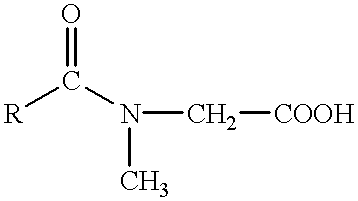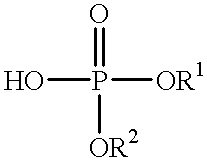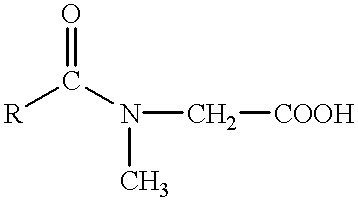Synergistic mixtures of phosphoric esters with carboxylic acids or carboxylic acid derivatives as asphaltene dispersants
a technology of phosphoric esters and carboxylic acids, which is applied in the direction of sealing/packing, group 5/15 element organic compounds, and wellbore/well accessories. it can solve the problems of affecting the dispersibility of asphalten
- Summary
- Abstract
- Description
- Claims
- Application Information
AI Technical Summary
Problems solved by technology
Method used
Image
Examples
examples 1 and 2
demonstrate the synergistic action of mixtures of carboxylic acids and phosphoric esters. At this low concentration, the individual components exhibit no action, but the mixture exhibits a good dispersion action. Further novel mixtures shown in Examples 3 to 5. In this series of experiments, the maximum ion action, A.sub.max, was about 140%.
example 1a
Example 1b
example 2
Dispersion
Testing of the Effectiveness of Asphaltene Dispersants
Principle of the Dispersion Test
This test is based on the fact that asphaltenes are soluble in aromatic hydrocarbons, but not aliphatic hydrocarbons. Dispersants can therefore be tested by dissolving the oil or extracted asphaltenes in an aromatic solvent and then adding an aliphatic hydrocarbon in order to produce a precipitate. Since asphaltenes have a dark color, the extent of the precipitate can be determined by a colorimetric measurement of the supernatant liquid. The darker the supernatant liquid, the more asphaltenes remain dispersed, ie. the better the dispersant. This test is described in CA-A-2,029,465. In on of the test, the precipitation medium is selected so that the asphaltenes precipitate predominantly, but not completely.
Dispersion Test Procedure
a) A 25% strength oil solution in toluene is filtered in order to remove impurities;
b) 9.5 ml of heptane as precipitant for asphaltenes and 0.5 ml of toluene / dis...
PUM
| Property | Measurement | Unit |
|---|---|---|
| volume | aaaaa | aaaaa |
| weight | aaaaa | aaaaa |
| chain length | aaaaa | aaaaa |
Abstract
Description
Claims
Application Information
 Login to View More
Login to View More - R&D
- Intellectual Property
- Life Sciences
- Materials
- Tech Scout
- Unparalleled Data Quality
- Higher Quality Content
- 60% Fewer Hallucinations
Browse by: Latest US Patents, China's latest patents, Technical Efficacy Thesaurus, Application Domain, Technology Topic, Popular Technical Reports.
© 2025 PatSnap. All rights reserved.Legal|Privacy policy|Modern Slavery Act Transparency Statement|Sitemap|About US| Contact US: help@patsnap.com



